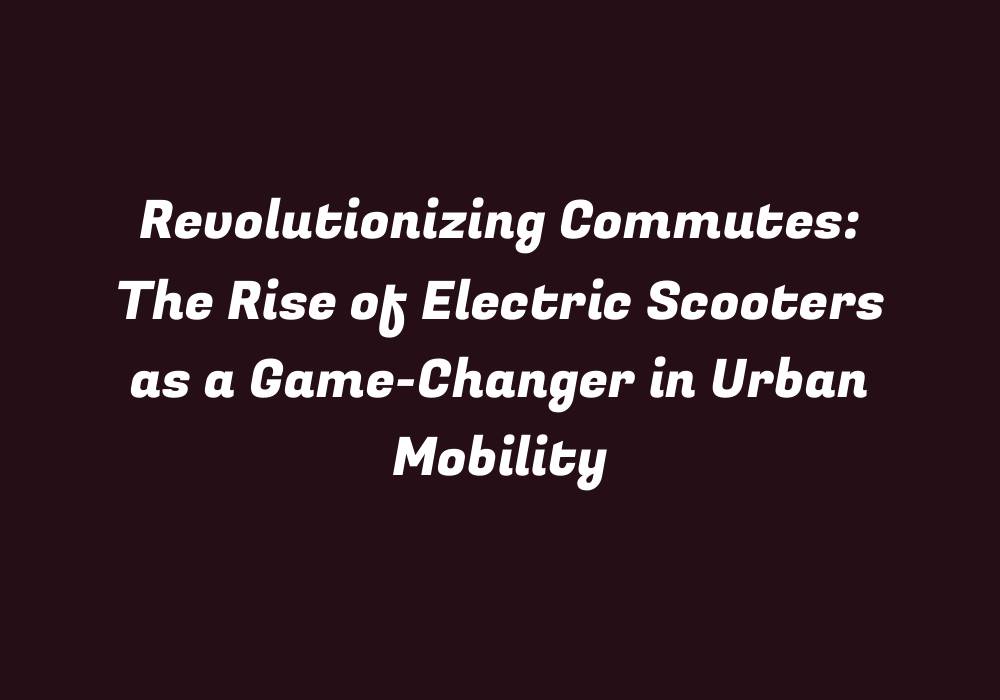Revolutionizing Commutes: The Rise of Electric Scooters as a Game-Changer in Urban Mobility
The transportation landscape has undergone numerous changes since the dawn of the modern era. From the advent of automobiles to the widespread adoption of public transportation systems, cities have been grappling with the need for accessible and efficient travel options. However, as our world becomes increasingly urbanized, it has become necessary to explore alternative modes of commuting that can adapt to the ever-changing needs of urban dwellers.
One innovative solution gaining traction in recent years is the rise of electric scooters. These compact, environmentally friendly vehicles are set to revolutionize urban mobility and offer a plethora of benefits to both commuters and city planners alike. In this article, we will delve into the various aspects of this transportation revolution and explore why electric scooters have become an essential part of the urban commute landscape.
Addressing Urban Mobility Challenges
The increasing number of vehicles on urban roads has led to congestion, pollution, and a host of other problems that hamper efficient transportation within cities. Electric scooters offer an alternative solution by addressing several key challenges faced in urban environments:
1. Congestion relief: With limited road space and traffic jams being a common occurrence, electric scooters can easily navigate through smaller gaps on the roads, making them more agile than motorcycles and cars. This allows for increased road utilization and improved traffic flow during peak hours.
2. Reducing air pollution: Electric scooters produce zero emissions, which significantly reduces air pollution compared to gasoline-powered vehicles. By incorporating green technology, urban mobility can be made more sustainable and environmentally friendly.
3. Enhancing accessibility for all: People with limited mobility often face challenges when using traditional public transportation or bicycles. Electric scooters are lightweight and easy to maneuver, making them a more inclusive mode of transport.
4. Promoting healthier lifestyles: Electric scooters offer an opportunity for exercise while commuting, as they require balance and some physical effort to ride. This can encourage individuals to maintain an active lifestyle even in the midst of their daily routines.
Key Benefits of Electric Scooters
In addition to addressing urban mobility challenges, electric scooters bring several advantages for both individual commuters and city planners:
1. Affordability: Purchasing an electric scooter is a cost-effective option compared to owning or leasing a car or motorbike, making them accessible to a wider range of income groups. This can promote financial inclusivity in urban transportation systems.
2. Convenience and flexibility: Electric scooters require minimal maintenance, are easy to store when not in use, and do not need parking spaces. Their portability allows for quick last-mile travel from public transportation hubs to final destinations.
3. Efficient usage of public space: With a smaller footprint compared to cars or motorbikes, electric scooters can be parked more easily and efficiently in public areas without occupying valuable parking spots.
4. Encouraging responsible urban planning: By promoting the adoption of electric scooters as an integral part of urban mobility systems, city planners can design infrastructure that better accommodates these vehicles, such as dedicated lanes or storage facilities at transit hubs. This can help create more efficient and sustainable transportation networks.
Challenges and Future Considerations
While electric scooters are showing promising potential in transforming urban mobility, there are still challenges to address:
1. Safety concerns: Electric scooter use has led to increased incidents of accidents, primarily due to improper riding techniques and inadequate regulation. Stricter regulations and safety measures are needed to ensure the well-being of riders and other road users.
2. Sustainability: While electric scooters reduce emissions compared to gasoline-powered vehicles, their batteries and manufacturing processes still have environmental impacts that need further evaluation. It is crucial to consider sustainable production methods and battery recycling when developing this transportation solution.
3. Equity: Access to electric scooters might not be equally available to all segments of society, potentially creating transportation inequities among different socio-economic groups. Efforts should be made to ensure that electric scooter services are inclusive and accessible for everyone.
Conclusion
Electric scooters have the potential to revolutionize urban mobility by addressing congestion, pollution, and accessibility issues in our rapidly urbanizing world. As they continue to gain popularity, it is important to address the challenges associated with their adoption while fostering a more inclusive and sustainable transportation landscape. By integrating electric scooters into our urban mobility systems and collaboratively working towards smart infrastructure development, cities can become more efficient, environmentally friendly, and accessible for all.
